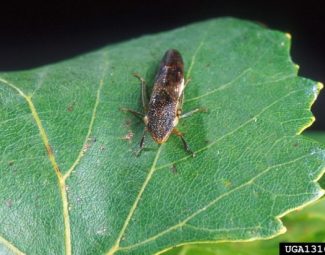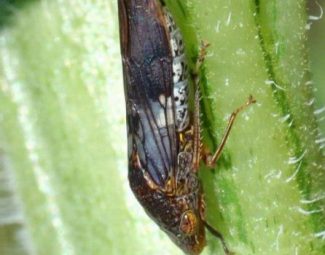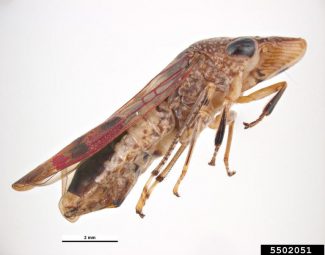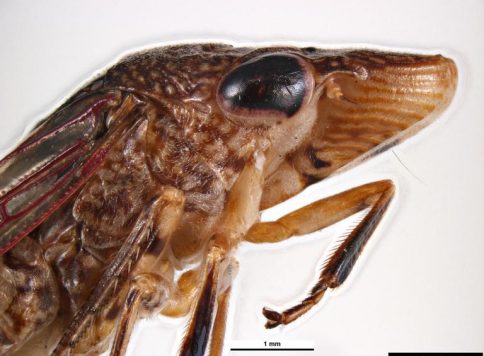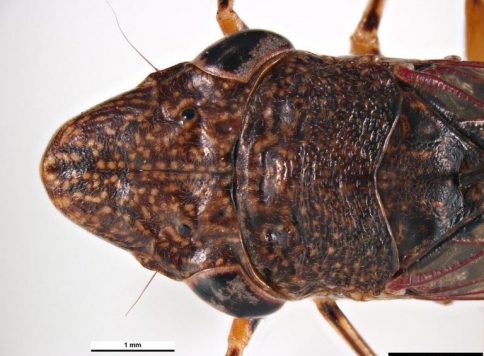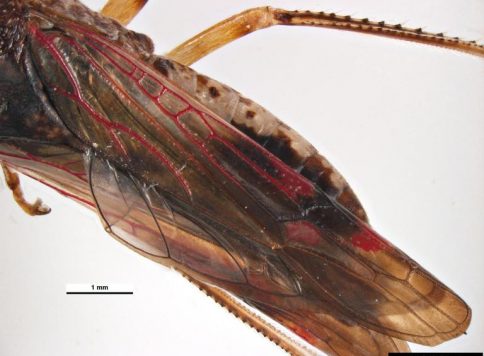Glassy-winged Sharpshooter
Insect Summary Report
Homalodisca vitripennis
General Information
- Glassy-winged Sharpshooter is native to the Southeastern US but has now spread across the Southern US to California.
- Pierce and suck plant sap from xylem tissue. Exudes a white substance that consists of 99.9% water, inorganic nutrients and ammonia. Exudates can coat leaves white when high populations are present. Feeding damage of little importance except under intense population conditions.
- Serves as a vector for plant diseases caused by the bacterium Xyella fastidiosa which include Pierce’s disease in grapes, phony peach disease, plum leaf scald, citrus chlorosis, and leaf scorch in oleander, almond, mulberry, sycamore, elm maple oak and cherry plum. Diseases seem to be host-specific and show little cross-virulence. Xyella fastidiosa can reside in resistant plants without causing disease.
- Diseased grape plants will appear wilted, leaves will turn red or yellow along margins, grape clusters will shrivel, leaves will fall leaving the petiole on the vine, and patches of green will be seen on new cane growth. Muscadine grapes are resistant to Pierce’s Disease.
- Mouthparts become inoculated when adults and nymphs feed on infected host plants. Inoculant is spread when other plants are fed upon. Nymphs lose inoculant after each molt and only re-aquire Xyella when new feeding of diseased tissue takes place.
- Preferred hosts include: citrus, holly, sunflower, and crape myrtle. Entire host range consists of more than 100 plant species, which include deciduous and non-deciduous trees as well as annual and perennial herbaceous plants.
- Very small populations can infect host plants, so the effectiveness of chemical control is uncertain. Insecticides may become important in controlling large populations that may affect yield and quality of crops.
- Strong fliers, which enhances ability to infect other host plants.
- Pheromone activity is unknown.
Life Cycle
- Eggs… (10-14 days) Laid underneath leaves just below the epidermis in linear groups of 3-28. Protected by chalky substance secreted from female’s abdomen and that is applied by wings.
- Nymph… 5 molts. Similar in appearance to adults, but are smaller and lack wings. Have large eyes and olive-green color.
- Adult… (Approx. 60 days)Approx. ½ in. long with dark brown or black bodies and white to yellow abdomens. Wings are clear with red veins. Yellow or white spots on head distinguish it from smoke-tree sharpshooter.
Over-wintering Strategy
Over-winters as adults. Feeds on citrus and other deciduous trees. Can also feed on sap of leafless twigs. Lays eggs in February-April in citrus groves and ornamental hosts.
Sampling
Yellow sticky traps and sweep nets can be used to detect adults. Random inspection of undersides of leaves can be used to look for egg masses. A general white coating of host plants may indicate the presence of adults and nymphs. Detection on host plants can be difficult due to camouflaged coloration.
Organic Control
- General Info
- Egg parasitoids of the genus Gonatocerus are native to Texas and provide effective biological control. They are not commercially available (2017, https://www.cdfa.ca.gov/pdcp/GWSS_Biological_Control_Agents.html). Control is more effective in summer as compared to spring. Parasitized eggs have a pinpoint hole in top.
- Other general predators include: lacewings, spiders, assassin bugs, and praying mantis.
- Commonly Used Products
- Ferti -Neem Oil
- Ferti-Organics Karanja Oil
- Biorepel (Garlic Oil)
- Ecotrol Plus (Rosemary and other essential oils)
- Neemix 4.5 (Botanical)
- Pyganic 1.4 (Botanical)
- Pyganic 5.0 (Botanical)
- Various Oils: Trilogy, Tritek
- Soaps: Des-X
- Mycotrol ESO (Biological)
- BoteGHA (Biological)
Cultural Control
- Maintain good fertility and mineral balance in plants. Identify macro- and micronutrient deficiencies by performing plant tissue and soil analysis. Adjust for deficiencies with foliar and soil applied applications of appropriate fertilizers.
- Remove dead host plants. Remove other host plants as soon as symptoms of disease appear.
- Remove weeds that serve as host plants.
More Images of the Glassy-winged Sharpshooter
Bibliography
- Image by USDA ARS Photo Unit, USDA Agriculture Research Service, Bugwood.org (adult on leaf)
- Image by Russ Ottens, University of Georgia, Bugwood.org (adult on the common sunflower)
- Images by Pest and Diseases Image Library, Bugwood.org (lateral, head, pronotum, and wings)
- http://www.ipm.ucdavis.edu/PMG/PESTNOTES/pn7492.html (Feeding, disease hosts, life cycle, sampling, conventional controls, parasitic wasps).
- http://creatures.ifas.ufl.edu/fruit/glassywinged_sharpshooter.htm (Distribution in Texas, strong fliers, egg grouping, preferred hosts, content of exudates, loss of inoculant after molting, conventional controls, resistance of muscadine grapes)

